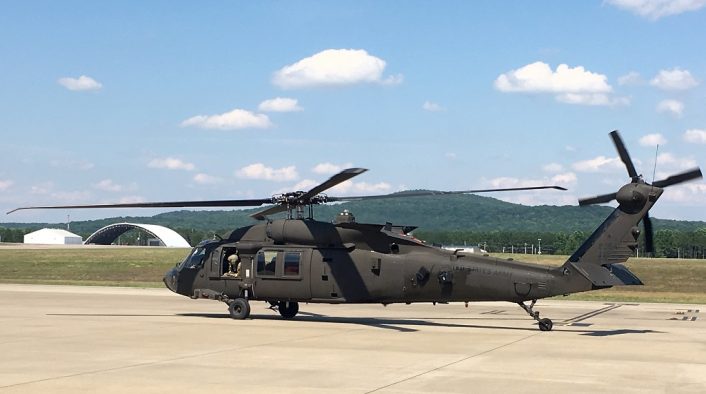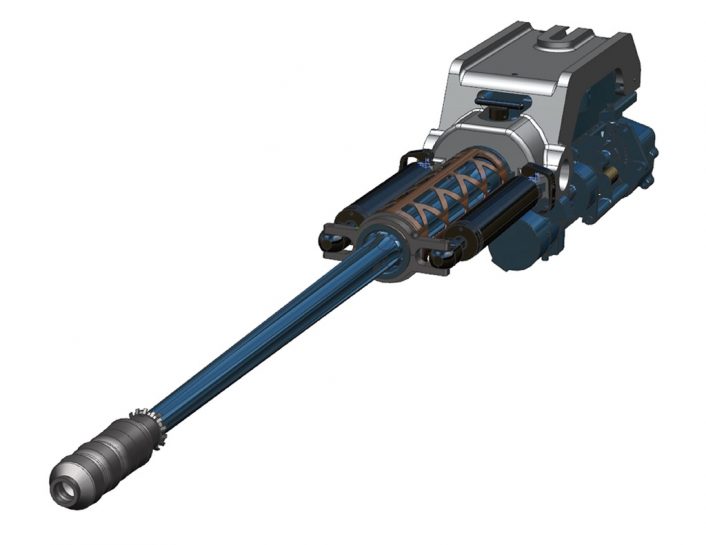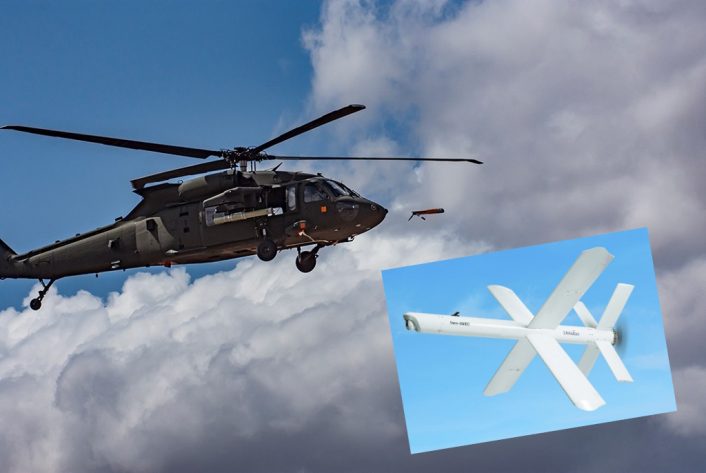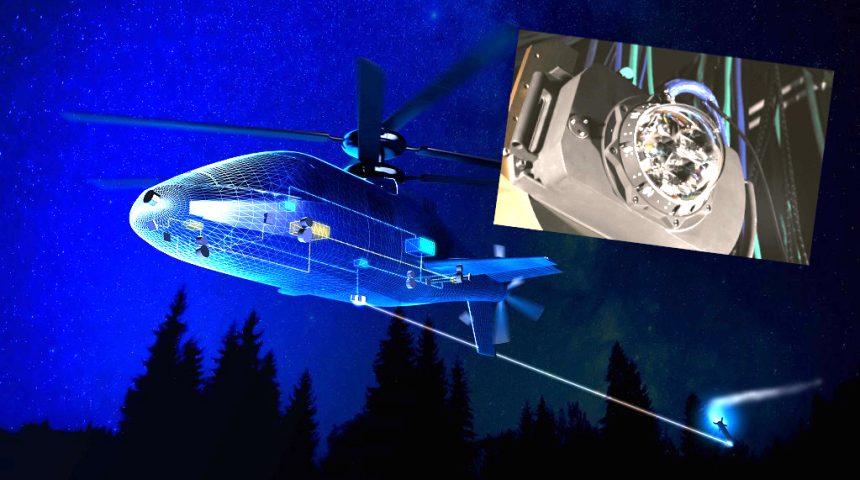Even if they did not submit a helicopter design, Northrop Grumman might be a big part of the FVL (Future Vertical Lift) with a multitude of technologies being developed specifically for the program.
As we reported multiple times in the past here at The Aviationist, the U.S. Army is working on the Future Vertical Lift program, which is set to replace its fleet of helicopters with a new family of helicopters that will share sensors, avionics, engines and countermeasure systems. Currently, two sub-programs are in the works: the Future Long Range Advanced Aircraft (FLRAA), a medium size assault/utility aircraft that will replace the UH-60 Black Hawk; and the Future Attack Reconnaissance Aircraft (FARA), a light armed reconnaissance helicopter that will be the successor of the retired OH-58 Kiowa Warrior.
Bell and Sikorsky have been selected as the finalists in both the competitions, submitting an advanced development of the V-280 Valor and the Defiant X, respectively, for FLRAA and the B-360 Invictus and the Raider X, respectively, for FARA. Although it did not submit any aircraft for the two competitions, a third company may become a big part of the program by providing its advanced technologies.
Northrop Grumman is, as a matter of fact, working on a multitude of subsystems for the Future Vertical Lift aircraft.
One of them is the Common Infrared Countermeasure (CIRCM), which reached last week a milestone, with the U.S. Army has declaring the system operationally suitable, effective and ready for full-rate production following a successful six-month Initial Operational Test and Evaluation (IOT&E) activity.
CIRCM is a lightweight dual-jammer Directional Infrared Counter Measures (DIRCM) system designed specifically to protect rotary wing and medium fixed wing aircraft from InfraRed-guided missiles. Northrop Grumman says that the system is built on open architecture to work with existing hardware and uses a compact pointer/tracker, a lightweight Commercial Off-The-Shelf (COTS) processor and advanced Quantum Cascade Laser (QCL) technology for greater reliability and scalability.
The first examples of CIRCM were delivered in late 2016, entering the IOT&E phase in 2019 at the Redstone Test Center at Redstone Arsenal (Alabama), where the system was first installed on the UH-60M. During the rigorous testing, the system was flown through a multitude of scenarios and environments to assess CIRCM’s ability to detect, engage and defeat threats. The system rapidly defeated all threats during IOT&E, proving it is ready to support the complex missions of the U.S. Army, according to Northrop Grumman’s press release.

At the beginning of the IOT&E, the Army said that the test flights consisted of air assault, air movement and aeromedical evacuation missions in both day and night environments, with a Multi-Spectral Sea and Land Target Simulator (MSALTS), provided by the U.S. Army’s Center for Countermeasures, engaging the aircrews as they performed the missions, forcing the test unit to react and employ tactics, techniques and procedures as if they were conducting combat operations.
CIRCM is set to replace the older and heavier BAE Advanced Threat Infrared Countermeasures (ATIRCM) that, while being described by the U.S. Army as highly combat effective, failed to be deployed on all the service’s helicopters as planned. Because of the weight, the system could not be installed on Apaches and Black Hawks, but only on CH-47 Chinooks.
As an interim solution while CIRCM was being developed, the Army acquired a number of Northrop Grumman Large Aircraft Infrared Countermeasure (LAIRCM) systems that, even if they experienced a somewhat troubled integration, were this time installed also on the UH-60 and AH-64.
After the installation on the current helicopters of the U.S. Army, CIRCM has been proposed for the installation on the Future Vertical Lift helicopters, together with the AN/APR-39E(V)2 digital Radar Warning Receiver/Electronic Warfare Management System. The latter, the next generation of the APR-39 RWR that has been in service for decades, is designed to detect, locate and identify sophisticated radio frequency-guided weapons and threats that are becoming more widely used in contested airspaces throughout the world.
Other technologies for the FVL program were disclosed during a media briefing about two weeks ago. One of them is the Modular Open Systems Architecture (MOSA), that will allow all the systems from different manufacturers to be integrated seamlessly on the aircraft. With MOSA, the aircraft will be built with common standards, coding language and interfaces available to all contractors that will allow components to be replaced by new ones with minimal integration work.
This concept will ease the fleet sustainment costs, allowing an easier data exchange, a more efficient preventive maintenance and a straightforward integration of new components to keep the fleet up to date.
Among the first capabilities that will benefit from MOSA are the Communications Navigation and Identification (CNI) systems. Jenna Paukstis, vice president of Northrop Grumman’s Communication Solutions Business units, said during the briefing that the CNI systems are being designed to be also platform-agnostic and thus shared by different types of aircraft, with MOSA allowing a quick third-party integration to further expand the capabilities if required. The data sharing allowed by the combination of the new CNI systems and MOSA will be in line with 5th generation aircraft.

As you may know from our previous articles here at The Aviationist, Northrop Grumman is heavily involved in the Active Electronically Scanned Array (AESA) radar technologies. These technologies are being used also for FVL, combining the latest developments in microelectronics and commercial technologies with software defined capabilities to develop a radar specifically for the new helicopters.
The new radar will leverage the know-how from the Apache’s Longbow radar and the MQ-1C Gray Eagle’s STARLite Extended Range Synthetic Aperture Radar/Ground Moving Target Indicator (SAR/GMTI) radar to provide a lightweight system optimized for multi-domain operations, as said during the briefing by Susan Bruce, vice president of Northrop Grumman’s Advanced Tactical Systems.
The Future Vertical Lift’s radar is not the only system to benefit from the Apache’s experience. Based on the AH-64’s M230 30 mm chain gun, Northrop Grumman is developing the Sky Viper 20 mm chain gun as a possible alternative to General Dynamics’ lightweight XM915 20mm three-barrel Gatling gun that is being integrated on the FARA prototypes. Along with the gun, special ammunition is being developed
Quinn Canole, deputy director of Northrop Grumman’s Guns Operating Unit, said that the new gun is being developed to provide superior performance compared to legacy Gatling guns, with lower recoil and dispersion, higher rate of fire, accuracy and reliability, easier maintenance and an overall increased lethality. A lower recoil will also help to cause less overall “wear and tear” on the aircraft itself.
The Sky Viper has passed an initial design review by the U.S. Army and the company has also performed risk-reduction testing on non-firing prototypes while the first production prototype is being built in anticipation of a full-scale live firing testing by this summer. The XM915 is scheduled for another round of live fire performance and reliability testing also this year at the U.S. Army Combat Capabilities Development Center (CCDC) Armaments Center after extensive test and evaluation. Similar activities will be performed for the Sky Viper.
Obviously, Northrop Grumman is working also on the other weapon systems that the Army requested for the FARA program, called Air Launched Effects (ALE). According to the U.S. Army, these autonomous Air Launched Effects are a critical component of the Army aviation’s advanced teaming capability to penetrate, disintegrate, and exploit Anti Access/Area Denial (A2/AD) threats, mid-tier Integrated Air Defense Systems (IADS) and long to medium-range fires in the close and deep maneuver areas, supporting the future Multi-Domain Operations battlefield.

During the media briefing, William Eledge, Program Manager for the Loitering Munitions Program, said that the weapon currently in the works combines Northrop Grumman’s technologies with the Hero 120 and Hero 400 loitering munitions, resulting in a new weapon called Hero ALE. The Hero ALE is made of an air vehicle and Radio Frequency payloads that will be able to detect and identify threats or act as decoys in Electronic Warfare (EW) scenarios.
A small rocket booster will help the Hero to “escape” the helicopter rotor’s downwash, which might influence its performance. The Hero will also be compatible with the existing M299 and M310 launchers, which can carry four and two missiles respectively, allowing the new ALE to be used not only by the FVL helicopters, but also by the Apache and the Gray Eagle.
During a question-and-answer session at the end of the briefing we asked about the possibility of integration on FVL aircraft of laser systems like the Self-protect High Energy Laser Demonstrator (SHiELD), which also sees Northrop Grumman’s participation, or offensive laser systems like the High Energy Weaponized laser that was tested some years ago by Raytheon and the U.S. Army. While these system’s integration is not currently scheduled, provisions are being made for future implementation of new laser systems.









